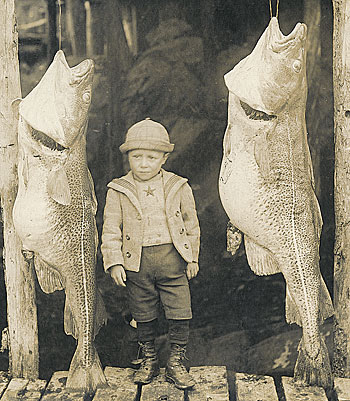By Eric P. Palkovacs, Assistant Professor of Ecology and Evolutionary Biology at UCSC
The disappearance of big fish can be traced to two distinct but related trends. First, large bodied species are disappearing and being replaced by smaller species. For example, in the Florida Keys, large groupers were abundant in the 1950s and 1960s but have since been largely replaced by small snappers. A second trend, and the primary focus here, is that the large bodied individuals within any given species are disappearing.

Large Atlantic cod caught off the coast of Newfoundland at the turn of the last century.
Photo courtesy of The Rooms Provincial Archives Division of Newfoundland and Labrador (www.therooms.ca)
For example, off the coast of Newfoundland, Atlantic cod weighing 60 lbs (27 kg) were present in the early 1900s. These giants are gone. The largest Atlantic cod are now less than a third this size. On the Pacific Coast, similar trends have been noted among blue rockfish, California sheephead, salmon, and even some harvested shellfish.
Fisheries harvest often selectively removes the largest fish from a population. This removal can change the average body size in a population over the short-term simply by taking out the largest fish and leaving the small ones. But what if fishing removes the biggest fish generation after generation? Evolutionary biologists have recently begun exploring this question with mathematical models, experiments, and data from harvested fish populations. The results are striking in their consistency – when we continuously catch the biggest fish, populations rapidly evolve smaller body size. Such downsizing can reflect genetic changes in the population as the small fish and their genes come to dominate many populations.
The revelation that human activity causes evolution in wild populations is not new; the evolution of pesticide resistance in agriculture and antibiotic resistance in medicine are well known examples. However, the realization that the intensity of modern fisheries is sufficient to cause the rapid evolution of fish populations on a global scale should be a sobering thought. In fact, fisheries are driving the most rapid rates of evolution ever observed in wild animal populations.
Why does the evolutionary downsizing of fish populations matter? From an economic perspective, people place a high value on large fish. Commercial fisheries benefit from the high prices these fish get at market. The ecotourism industry benefits because recreational divers and anglers are willing to pay large sums to encounter large fish in their natural environments. But large fish provide ecological benefits as well.
Large fish are important for the growth and stability of populations. Large females produce many more eggs than small females and therefore contribute disproportionately to population growth. The evolution of smaller size causes populations to recover more slowly when fishing stops. This effect may be at least partly responsible for the stalled recovery of Atlantic cod populations.
Large fish are a crucial component of marine ecosystems. As top predators, they control the abundance of other species in the food web, and their loss can trigger entire ecosystem shifts. In the North Atlantic, the loss of large Atlantic cod led to a dramatic increase in populations of prey fish, an effect that cascaded through the food web to impact yet other parts of the ecosystem. Closer to home, large California sheephead are important urchin predators that help maintain the health of kelp forests. Small sheephead do not consume urchins as effectively. Thus, the loss of large sheephead may cause an increase in urchin populations that may lead to the loss of kelp.
Research activity on the causes and consequences of evolutionary downsizing are ongoing. Nonetheless, biologists have come a long way towards understanding the value of large fish and the reasons why they are disappearing. The lessons learned should provide strong incentives to preserve and restore them for the myriad benefits they provide.
•••
Note: I will be giving a presentation at the Seymour Marine Discovery Center’s Science Sunday Lecture Series on Sept 20 at 1:00 pm titled “Evolution in the Anthropocene: How human activity is changing the shape of life.” In this talk, I will discuss the loss of large fish and provide other examples of how humans are shaping evolution and why it matters.
The second article in this series will focus on conservation strategies such as harvest rules and marine protected areas that can be used to restore large fish.